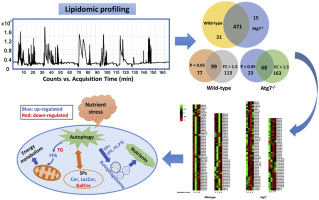当前位置:
X-MOL 学术
›
Anal. Chim. Acta
›
论文详情
Our official English website, www.x-mol.net, welcomes your feedback! (Note: you will need to create a separate account there.)
Lipid metabolism in mouse embryonic fibroblast cells in response to autophagy induced by nutrient stress
Analytica Chimica Acta ( IF 6.2 ) Pub Date : 2018-12-01 , DOI: 10.1016/j.aca.2017.11.005 Sensen Shen , Li Yang , Linnan Li , Yu Bai , Huwei Liu
Analytica Chimica Acta ( IF 6.2 ) Pub Date : 2018-12-01 , DOI: 10.1016/j.aca.2017.11.005 Sensen Shen , Li Yang , Linnan Li , Yu Bai , Huwei Liu

|
Autophagy is of great significance in maintaining cellular homeostasis. Aberrant autophagy has been reported to contribute to the disease aetiology of metabolic syndrome, especially several key lysosomal storage disorders. However, the molecular mechanisms and the correlation between autophagy and lipid metabolism remains unclear. This study was designed and aimed to reveal the alteration of lipid metabolism in response to the autophagy induced by nutrient stress to give new insights into the molecular mechanisms between autophagy and lipid metabolism. An online normal-phase/reversed-phase two-dimensional liquid chromatography-mass spectrometry (NP/RP 2D LC-MS) method was developed to perform the lipidomics analysis of Atg7-/- mouse embryonic fibroblast cells (MEFs) and wild-type MEFs under nutrient stress. 48 and 35 lipid species in wild-type and Atg7-/- MEFs respectively finally meet the screening criteria with p-value less than 0.05 and fold change more than 1.5 in response to nutrient stress. Their alterations indicated that autophagy participated lipid metabolism to generate energy and form autophagosomes with significantly increased free fatty acids and glycerophospholipids, which protected wild-type MEFs from serious damages and delayed cell death. However, in Atg7-/- MEFs, due to the inhibition of autophagy, lipids were continuously consumed and cells suffered from damages even death. These results illustrated the close relationship between autophagy and lipid metabolism comprehensively and revealed diverse lipid targets for the investigation of autophagy.
中文翻译:

小鼠胚胎成纤维细胞的脂质代谢响应营养应激诱导的自噬
自噬对于维持细胞稳态具有重要意义。据报道,异常自噬导致代谢综合征的疾病病因,尤其是几种关键的溶酶体贮积症。然而,自噬与脂质代谢之间的分子机制和相关性尚不清楚。本研究旨在揭示脂质代谢对营养应激诱导的自噬反应的改变,为自噬和脂质代谢之间的分子机制提供新的见解。开发了一种在线正相/反相二维液相色谱-质谱 (NP/RP 2D LC-MS) 方法来对 Atg7-/- 小鼠胚胎成纤维细胞 (MEF) 和野生型进行脂质组学分析。营养胁迫下的 MEF。野生型和 Atg7-/- MEF 中分别有 48 和 35 种脂质最终符合筛选标准,p 值小于 0.05,倍数变化大于 1.5,以响应营养胁迫。它们的改变表明自噬参与脂质代谢产生能量并形成游离脂肪酸和甘油磷脂显着增加的自噬体,从而保护野生型 MEF 免受严重损伤和延迟细胞死亡。然而,在Atg7-/- MEFs中,由于自噬受到抑制,脂质不断被消耗,细胞受到损伤甚至死亡。这些结果全面说明了自噬与脂质代谢之间的密切关系,并揭示了自噬研究的多种脂质靶标。05 和倍数变化超过 1.5 以响应营养压力。它们的改变表明自噬参与脂质代谢产生能量并形成游离脂肪酸和甘油磷脂显着增加的自噬体,从而保护野生型 MEF 免受严重损伤和延迟细胞死亡。然而,在Atg7-/- MEFs中,由于自噬受到抑制,脂质不断被消耗,细胞受到损伤甚至死亡。这些结果全面说明了自噬与脂质代谢之间的密切关系,并揭示了自噬研究的多种脂质靶标。05 和倍数变化超过 1.5 以响应营养压力。它们的改变表明自噬参与脂质代谢产生能量并形成游离脂肪酸和甘油磷脂显着增加的自噬体,从而保护野生型 MEF 免受严重损伤和延迟细胞死亡。然而,在Atg7-/- MEFs中,由于自噬受到抑制,脂质不断被消耗,细胞受到损伤甚至死亡。这些结果全面说明了自噬与脂质代谢之间的密切关系,并揭示了自噬研究的多种脂质靶标。它们的改变表明自噬参与脂质代谢产生能量并形成游离脂肪酸和甘油磷脂显着增加的自噬体,从而保护野生型 MEF 免受严重损伤和延迟细胞死亡。然而,在Atg7-/- MEFs中,由于自噬受到抑制,脂质不断被消耗,细胞受到损伤甚至死亡。这些结果全面说明了自噬与脂质代谢之间的密切关系,并揭示了自噬研究的多种脂质靶标。它们的改变表明自噬参与脂质代谢产生能量并形成游离脂肪酸和甘油磷脂显着增加的自噬体,从而保护野生型 MEF 免受严重损伤和延迟细胞死亡。然而,在Atg7-/- MEFs中,由于自噬受到抑制,脂质不断被消耗,细胞受到损伤甚至死亡。这些结果全面说明了自噬与脂质代谢之间的密切关系,并揭示了自噬研究的多种脂质靶标。
更新日期:2018-12-01
中文翻译:

小鼠胚胎成纤维细胞的脂质代谢响应营养应激诱导的自噬
自噬对于维持细胞稳态具有重要意义。据报道,异常自噬导致代谢综合征的疾病病因,尤其是几种关键的溶酶体贮积症。然而,自噬与脂质代谢之间的分子机制和相关性尚不清楚。本研究旨在揭示脂质代谢对营养应激诱导的自噬反应的改变,为自噬和脂质代谢之间的分子机制提供新的见解。开发了一种在线正相/反相二维液相色谱-质谱 (NP/RP 2D LC-MS) 方法来对 Atg7-/- 小鼠胚胎成纤维细胞 (MEF) 和野生型进行脂质组学分析。营养胁迫下的 MEF。野生型和 Atg7-/- MEF 中分别有 48 和 35 种脂质最终符合筛选标准,p 值小于 0.05,倍数变化大于 1.5,以响应营养胁迫。它们的改变表明自噬参与脂质代谢产生能量并形成游离脂肪酸和甘油磷脂显着增加的自噬体,从而保护野生型 MEF 免受严重损伤和延迟细胞死亡。然而,在Atg7-/- MEFs中,由于自噬受到抑制,脂质不断被消耗,细胞受到损伤甚至死亡。这些结果全面说明了自噬与脂质代谢之间的密切关系,并揭示了自噬研究的多种脂质靶标。05 和倍数变化超过 1.5 以响应营养压力。它们的改变表明自噬参与脂质代谢产生能量并形成游离脂肪酸和甘油磷脂显着增加的自噬体,从而保护野生型 MEF 免受严重损伤和延迟细胞死亡。然而,在Atg7-/- MEFs中,由于自噬受到抑制,脂质不断被消耗,细胞受到损伤甚至死亡。这些结果全面说明了自噬与脂质代谢之间的密切关系,并揭示了自噬研究的多种脂质靶标。05 和倍数变化超过 1.5 以响应营养压力。它们的改变表明自噬参与脂质代谢产生能量并形成游离脂肪酸和甘油磷脂显着增加的自噬体,从而保护野生型 MEF 免受严重损伤和延迟细胞死亡。然而,在Atg7-/- MEFs中,由于自噬受到抑制,脂质不断被消耗,细胞受到损伤甚至死亡。这些结果全面说明了自噬与脂质代谢之间的密切关系,并揭示了自噬研究的多种脂质靶标。它们的改变表明自噬参与脂质代谢产生能量并形成游离脂肪酸和甘油磷脂显着增加的自噬体,从而保护野生型 MEF 免受严重损伤和延迟细胞死亡。然而,在Atg7-/- MEFs中,由于自噬受到抑制,脂质不断被消耗,细胞受到损伤甚至死亡。这些结果全面说明了自噬与脂质代谢之间的密切关系,并揭示了自噬研究的多种脂质靶标。它们的改变表明自噬参与脂质代谢产生能量并形成游离脂肪酸和甘油磷脂显着增加的自噬体,从而保护野生型 MEF 免受严重损伤和延迟细胞死亡。然而,在Atg7-/- MEFs中,由于自噬受到抑制,脂质不断被消耗,细胞受到损伤甚至死亡。这些结果全面说明了自噬与脂质代谢之间的密切关系,并揭示了自噬研究的多种脂质靶标。



























 京公网安备 11010802027423号
京公网安备 11010802027423号